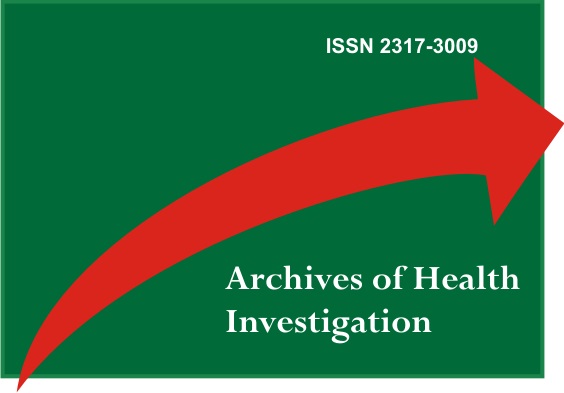Sialodenite Esclerosante Crônica: relato de caso
DOI:
https://doi.org/10.21270/archi.v10i8.5444Palavras-chave:
Sialadenite, Glândulas Salivares, Neoplasias BucaisResumo
A sialadenite esclerosante crônica foi descrita pela primeira vez na Alemanha por Kuttner, em 1896. É uma lesão benigna semelhante a um tumor que afeta predominantemente a glândula submandibular e é uma doença inflamatória crônica relativamente incomum da glândula salivar. Esta lesão é caracterizada histologicamente por atrofia acinar, fibrose periductal e infiltração de glândulas por linfócitos com formação de folículos linfóides, perda de ácino e, eventualmente, esclerose acentuada da glândula salivar e geralmente ocorre em idosos e adultos de meia idade com ligeira predominância masculina. O relatório descreve um paciente, R.J.R.C, um homem de 53 anos, apresentando um histórico de dois anos de massa sublingual moderada e indolor, relacionada a um edentulismo parcial dos dentes 46 e 47.
Downloads
Referências
Küttner H. Über entzündliche tumoren der submaxillar-speicheldrü-se. Bruns’Beitr Klin Chir. 1896; 15: 815-828.
Seifert G. Tumour-like lesions of the salivary glands. The new WHO classification. Pathol Res Pract. 1992;188:836-46.
Seifert G, Sobin LH. The World Health Organization’s Histological Classification of Salivary Gland Tumors. A commentary on the second edition. Cancer. 1992;70:379-85.
Seifert G, Donath K. On the pathogenesis of the Küttner tumor of the submandibular gland -- Analysis of 349 cases with chronic sialadenitis of the submandibular. HNO. 1977;25:81-92.
Teymoortash A, Tiemann M, Schrader C, Werner JA. Characterization of lymphoid infiltrates in chronic obstructive sialadenitis associated with sialolithiasis. J Oral Pathol Med. 2004;33:300-4.
Martinez CN, Baquera HJ, Sánchez CR, Márquez RM, Ortiz Hidalgo C. Küttner’s tumour (chronic sclerosing sialadenitis) clinical, pathological and immunohistochemical study in 8 cases of a little-known entity. Acta Otorrinolaringol Esp 2007; 58(1):25-30.
Rasanen O, Jokinen K, Dammert K. Sclerosing inflammation of the submandibular salivary gland (Kuttner tumour). A progressive plasmacellular ductitis. Acta Otolaryngol 1972;74:297–301
Tiemann M, Teymoortash A, Schrader C, Werner JA, Parwaresch R, Seifert G, et al. Chronic sclerosing sialadenitis of the submandibular gland is mainly due to a T lymphocyte immune reaction. Mod Pathol. 2002;15:845-52.
Ikeda M, Ikui A, Tanaka M, Omori H, Tomita H. Immuno-histopathological investigation on unspecific chronic sclerosing sialadenitis of the submandibular gland (Kuttner tumor). Auris Nasus Larynx 1994;21:103–10.
Blanco M, Mesko T, Cura M, Cabello-Inchausti B. Chronic sclerosing sialadenitis (Kuttner’s tumor): unusual presentation with bilateral involvement of major and minor salivary glands. Ann Diagn Pathol. 2003;7:25-30.
Toussirot, É., & Roudier, J. Epstein–Barr virus in autoimmune diseases. Bestb practice & research Clinical rheumatology 2008, 22(5): 883-96.
Geyer JT, Ferry JA, Harris NL, Stone JH, Zukerberg LR, Lauwers GY, et al. Chronic sclerosing sialadenitis (Küttner tumor) is an IgG4-associated disease. Am J Surg Pathol. 2010;34:202-10.


